This post contains affiliate links.
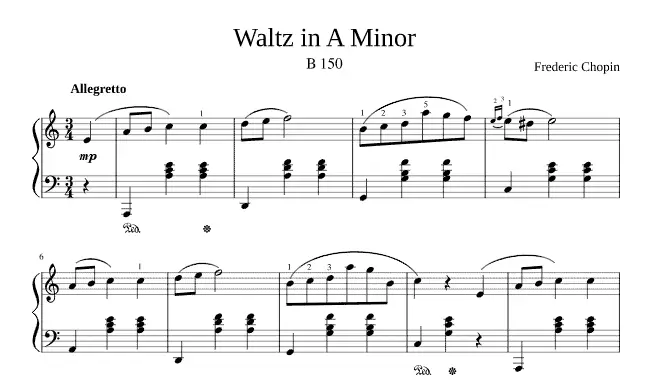
Waltz in A minor, B. 150 by Chopin is a pretty piece and is considered the easiest among Chopin’s Waltzes. The piece seems easy enough after looking at the sheet music and listening to the recording. For most of the piece, your right-hand plays melodies while your left-hand repeats chords.
However, looks can be deceiving. While 90% of the piece is easy to learn, the remaining 10% are difficult and will take the most amount of time to learn and perfect.
In this article, I’ll talk about where this difficult 10% are in the piece, why it’s so difficult to learn, and tips to help you conquer this hurdle and master the piece.
I’ll also talk about how long Waltz in A minor takes to learn and the grade level of the piece.
How hard is Waltz in A minor?
Although considered the easiest Chopin Waltz, Waltz in A minor is still a difficult piece and beginners shouldn’t learn it. The piece is difficult mostly because of the arpeggio at bar 22, the trills and the grace notes. Beginners will be better off learning easier pieces to learn the fundamentals.
Only piano players that have been playing the piano for a while and have got the fundamentals down should start learning this piece. The fundamentals include things like: being able to read and understand sheet music, playing with both hands in rhythm, having experience using the sustain pedal, being able to count quarter notes and eighth notes, etc.
While technically you can learn this piece even if you’re a beginner, it’ll be too inefficient since you aren’t ready and you’ll progress faster by learning easier pieces. I talk more about the reasons why learning a piece you aren’t ready for is bad and why it’s better to learn easier pieces in How To Know If A Piano Piece Is Too Hard For You
Now let’s go through the difficult parts of this Waltz:
The arpeggio at bar 22
This dreaded bar 22 is the hardest part of the piece and you’ll be spending the most amount of time on this part.
An arpeggio for those that don’t know, is a broken chord where you play one note at a time instead of all at once. In this Waltz, the arpeggio is of the E Major scale and includes the notes E, G#, and B.
This sequence of notes will be played in 3 successive octaves. The “8” symbol on top of the staff means the sequence of notes will be played one octave higher.
The “3” and “5” below the notes are called triplets and quintuplets respectively. For a triplet, 1 quarter note equals 3 eighth notes instead of 2. For a quintuplet, 1 quarter note equals 5 sixteenth notes instead of 4.
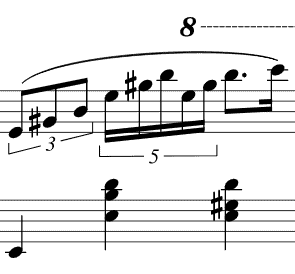
Now, the reasons why this one bar is so hard are because of the awkward fingerings of the arpeggio, the speed at which you have to play the arpeggio at, and the counting.
You’ll have to use 1 2 3 fingerings to play the arpeggio, so your thumb, index finger, and middle finger. Don’t use 1 3 5 fingerings because you will need to lift your whole hand to move to the next octave, which means you won’t be able to play the bar as quickly as tucking your thumb to reach the next E note.
Not to mention, if you use 1 3 5 fingerings, you won’t be able to play the arpeggio with the same volume because of the weak pinky finger.
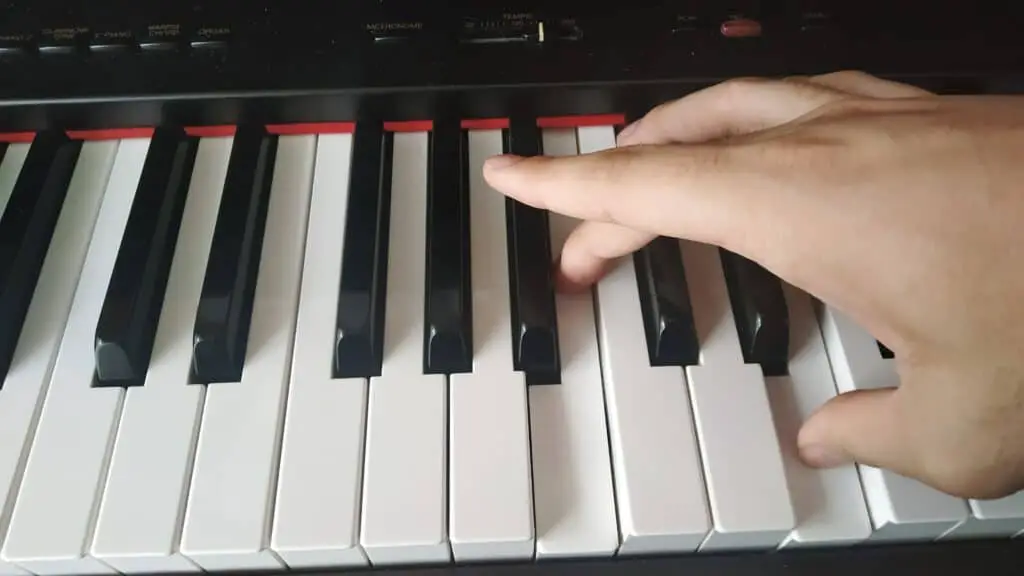
However, even with 1 2 3 fingerings, the arpeggio is still hard to play correctly. Because of the quintuplet, you have to play the arpeggio quickly. This combined with the thumb tuck means you’ll accidentally press the wrong keys a lot at first.
And because you need to jump to the next octave quickly, there will be a significant time lag to go from B to the E of the next octave. This means it’ll be difficult to play the arpeggio evenly.
Grace notes
Grace notes show up everywhere in this Waltz. Grace notes are those smaller notes written before the normal size notes:
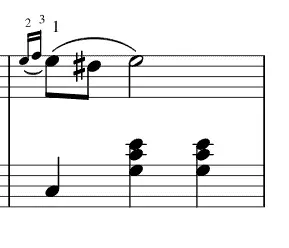
Grace notes are played before the first beat of the bar starts. This means grace notes have to be played quickly before the first beat starts.
As you can see in the example picture, the first beat starts with C in the left hand and E on the right hand and the grace notes E and F have to be played before that first beat starts.
Grace notes are tricky to get right the first time for anyone who isn’t familiar with them. However, once you play one grace note correctly, you’ll be able to easily play the other grace notes that show up in the Waltz.
The trill
In Waltz in A minor, there’s one trill that shows up a the end of the piece:
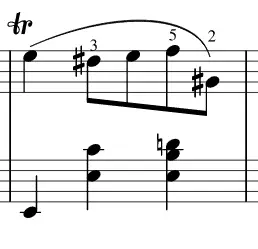
Trills are where you have the play the two notes as fast as you can, over and over. In this case, although there’s only 1 note, you’ll be playing E and F quickly, over and over.
You’ll be playing this trill within the time of a quarter note, as seen in the picture above.
Tips on conquering the hard parts of Waltz in A minor
The arpeggio
Tip #1: Practice the arpeggio off-beat: one of the challenges of this arpeggio is to be able to land on the correct notes in rhythm.
Thus, try to practice the arpeggio off-beat, similar to jazz, where you don’t play the arpeggio at the rhythm specified. This is best demonstrated through this video:
You play the 1st and 2nd notes quickly, the 2nd and 3rd a bit slower, and repeat this pattern through the entire arpeggio. You can switch it up and play the 1st and 2nd notes slow, 2nd and 3rd fast.
Also, when practicing the arpeggio off-beat, only do it with your right hand since it doesn’t make sense to practice off-beat with both hands and you’ll only be making it harder to practice.
Try this out! When I was learning this piece, I was surprised at how much this helped me land on the right notes of the arpeggio. After a few times practicing off-beat, I noticed I was slowly getting the arpeggio right a lot faster compared to practicing it normally.
While you are at it, why not start learning and practicing other scales and arpeggios also? I discuss the huge benefits learning scales and arpeggios do for your piano playing in 9 Reasons Why you Must Practice your Scales and Arpeggios.
Tip #2: Practice slowly: when practicing, play the arpeggio slower at the tempo specified. If you find that you’re still messing up and playing the wrong notes, go even slower. Go so slow that you can play the arpeggio correctly 100% of the time.
Once you can play the arpeggio at a slow speed, bump up the speed one step at a time until you can play the required tempo. As a wise man once said:” If you can play slowly, you can play quickly.”
Tip #3: Practice the arpeggio evenly at first: because of the triplet and quintuplet, this arpeggio will sound like it’s being sped up. Listen to the recording and you’ll notice this.
When you first practice, treat the arpeggio as triplets-only. Being able to land the correct comes first and then play at the right rhythm. It’s easier to get each thing right first and then combine them at the end.
Tip #4: Practice the arpeggio as if it’s being sped up: once you can land the notes correctly, the next challenge is to play the arpeggio in the correct rhythm. Counting triplets and quintuplets are tricky and watching youtube videos on the matter is helpful.
On the other hand, instead of counting, you can play the arpeggio as if it’s being sped up and listen to the recording at the same time to make sure you get the timing correct.
I find it tedious to sit there and clap out the triplets and quintuplets so this is what I do instead. It works for me so you can try it out if you wish to.
The grace notes
The tricky part to grace notes is playing them before the first beat of the bar starts and there are previous bars you need to play.
So focus on only moving from the last note of the previous bar to the grace notes and then the first beat of the next bar. Do this over and over until you get it right.
Also, listen to the recording constantly because it’ll help you play the grace notes correctly.
The trills
The trick to learning the trill is the same as grace notes: isolate the trill and the neighbouring notes, practice that over and over, and listen to the recording to make sure you get it right.
Also, play this trill with your thumb and index fingers because it’s hard to play trill quickly with weaker fingers.
What grade level is Waltz in A minor?
Waltz in A minor is around RCM level 6. Without the arpeggio section, it would be a level 4-5 in difficulty. In terms of ABRSM grade, the piece is grade 6-7 since a particular ABRSM grade is harder than its RCM counterpart.
What long does the Waltz in A minor take to learn?
While everyone is different, I would say it could take anywhere from 2-4 weeks to learn the piece for an average piano player, depending on how long you’re practicing every day.
You can learn the whole piece except the arpeggio bar in one week if you’re spending 30 mins – 1 hour practicing every day. The arpeggio could need a whole week to be able to play correctly. It’s just that hard!
For me, I spent 1 month learning this piece, with the majority of that time used to practicing that dreadful arpeggio bar.
Next piece to learn
After completing this piece, I recommend taking a look at Bach’s Prelude in C Major. It’s a beautiful piece and easy to learn. This is the perfect piece to take it easy after this difficult Waltz. The experience you get from this Waltz will make it a breeze to learn the Bach Prelude.
I wrote a guide on learning this Prelude in C Major.

